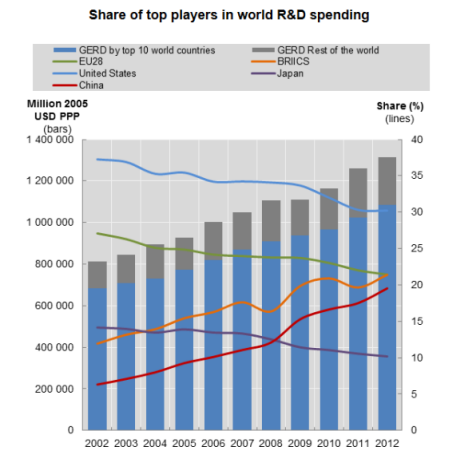China Headed to Overtake EU, US in Science & Technology Spending
Squeezed R&D budgets in the EU, Japan and US are reducing the weight of advanced economies in science and technology research, patent applications and scientific publications and leaving China on track to be the world’s top R&D spender by around 2019, according to a new OECD report.
The OECD Science, Technology and Industry Outlook 2014 finds that with R&D spending by most OECD governments and businesses yet to recover from the economic crisis, the OECD’s share in global R&D spending has slipped from 90% to 70% in a decade.
Annual growth in R&D spending across OECD countries was 1.6% over 2008-12, half the rate of 2001-08 as public R&D budgets stagnated or shrank in many countries and business investment was subdued. China’s R&D spending meanwhile doubled from 2008 to 2012.
Gross domestic expenditure on R&D (GERD) in 2012 was USD 257 billion in China, USD 397 billion in the United States, USD 282 billion for the EU28 and USD 134 billion in Japan.
 OECD Science, Technology and Industry Outlook 2014
OECD Science, Technology and Industry Outlook 2014
The report warns that with public finances still tight in many countries, the ability of governments to compensate for lower business R&D with public funding, as they did during the worst of the economic downturn, has become more limited. Other key findings include:
- 2012 R&D spending surpassed USD 1.1 trillion in OECD countries and stood at USD 330 billion in the BRIICS (Brazil, Russia, India, Indonesia, China and South Africa).
- Korea became the world’s most R&D intensive country in 2012, spending 4.36% of GDP on R&D, overtaking Israel (3.93%) and versus an OECD average of 2.40%.
- The BRIICS produced around 12% of the top-quality scientific publications in 2013, almost twice its share of a decade ago and compared to 28% in the United States.
- China and Korea are now the main destinations of scientific authors from the United States and experienced a net “brain gain” over 1996-2011.
- European countries are diverging in R&D as some move closer to their R&D/GDP targets (Denmark, Germany) and others (Portugal, Spain) fall further behind.
- In most countries, 10% to 20% of business R&D is funded with public money, using various investment instruments and government targets.
 OECD Main Science and Technology Indicators Database, Eurostat and UNESCO Institute of Statistics, June 2014
OECD Main Science and Technology Indicators Database, Eurostat and UNESCO Institute of Statistics, June 2014
The report draws on a policy survey conducted every two years in more than 45 OECD and emerging economies. You can read the report, the Highlights and Country Notes included under the table of content.
